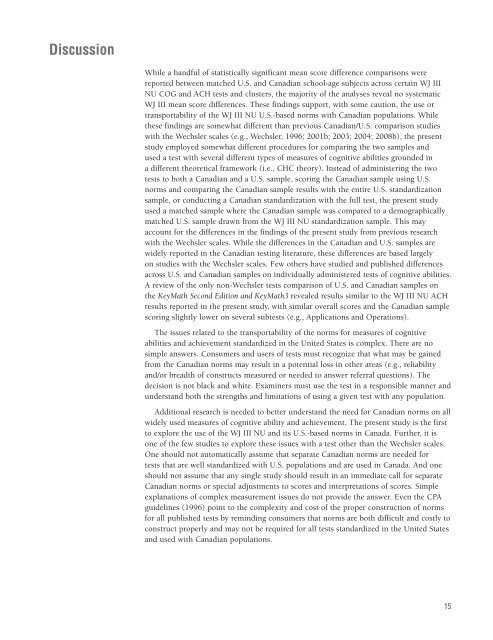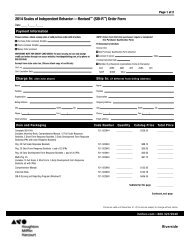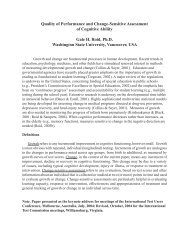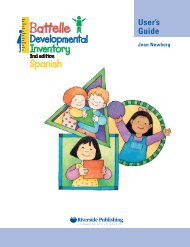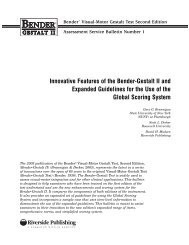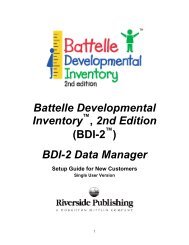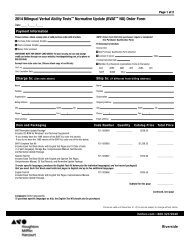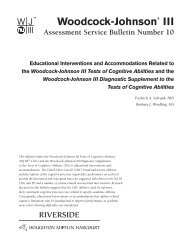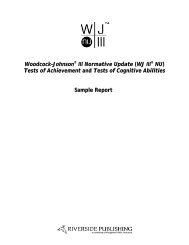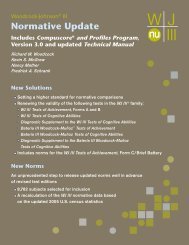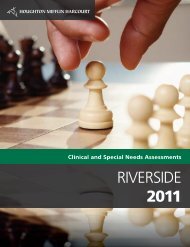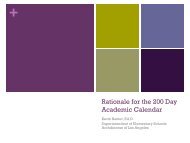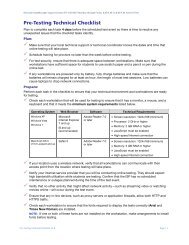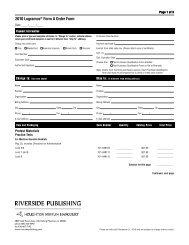Woodcock-Johnson® III - Riverside Publishing
Woodcock-Johnson® III - Riverside Publishing
Woodcock-Johnson® III - Riverside Publishing
- No tags were found...
You also want an ePaper? Increase the reach of your titles
YUMPU automatically turns print PDFs into web optimized ePapers that Google loves.
DiscussionWhile a handful of statistically significant mean score difference comparisons werereported between matched U.S. and Canadian school-age subjects across certain WJ <strong>III</strong>NU COG and ACH tests and clusters, the majority of the analyses reveal no systematicWJ <strong>III</strong> mean score differences. These findings support, with some caution, the use ortransportability of the WJ <strong>III</strong> NU U.S.-based norms with Canadian populations. Whilethese findings are somewhat different than previous Canadian/U.S. comparison studieswith the Wechsler scales (e.g., Wechsler, 1996; 2001b; 2003; 2004; 2008b), the presentstudy employed somewhat different procedures for comparing the two samples andused a test with several different types of measures of cognitive abilities grounded ina different theoretical framework (i.e., CHC theory). Instead of administering the twotests to both a Canadian and a U.S. sample, scoring the Canadian sample using U.S.norms and comparing the Canadian sample results with the entire U.S. standardizationsample, or conducting a Canadian standardization with the full test, the present studyused a matched sample where the Canadian sample was compared to a demographicallymatched U.S. sample drawn from the WJ <strong>III</strong> NU standardization sample. This mayaccount for the differences in the findings of the present study from previous researchwith the Wechsler scales. While the differences in the Canadian and U.S. samples arewidely reported in the Canadian testing literature, these differences are based largelyon studies with the Wechsler scales. Few others have studied and published differencesacross U.S. and Canadian samples on individually administered tests of cognitive abilities.A review of the only non-Wechsler tests comparison of U.S. and Canadian samples onthe KeyMath Second Edition and KeyMath3 revealed results similar to the WJ <strong>III</strong> NU ACHresults reported in the present study, with similar overall scores and the Canadian samplescoring slightly lower on several subtests (e.g., Applications and Operations).The issues related to the transportability of the norms for measures of cognitiveabilities and achievement standardized in the United States is complex. There are nosimple answers. Consumers and users of tests must recognize that what may be gainedfrom the Canadian norms may result in a potential loss in other areas (e.g., reliabilityand/or breadth of constructs measured or needed to answer referral questions). Thedecision is not black and white. Examiners must use the test in a responsible manner andunderstand both the strengths and limitations of using a given test with any population.Additional research is needed to better understand the need for Canadian norms on allwidely used measures of cognitive ability and achievement. The present study is the firstto explore the use of the WJ <strong>III</strong> NU and its U.S.-based norms in Canada. Further, it isone of the few studies to explore these issues with a test other than the Wechsler scales.One should not automatically assume that separate Canadian norms are needed fortests that are well standardized with U.S. populations and are used in Canada. And oneshould not assume that any single study should result in an immediate call for separateCanadian norms or special adjustments to scores and interpretations of scores. Simpleexplanations of complex measurement issues do not provide the answer. Even the CPAguidelines (1996) point to the complexity and cost of the proper construction of normsfor all published tests by reminding consumers that norms are both difficult and costly toconstruct properly and may not be required for all tests standardized in the United Statesand used with Canadian populations.15


